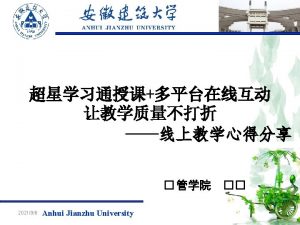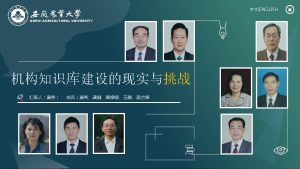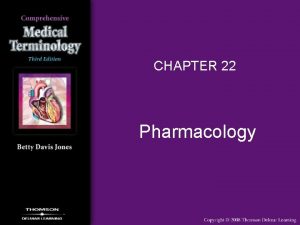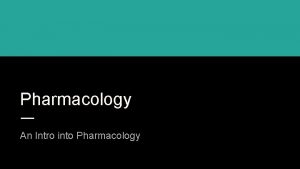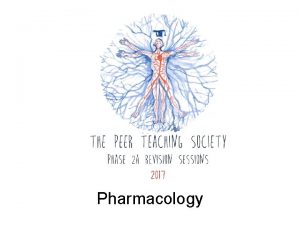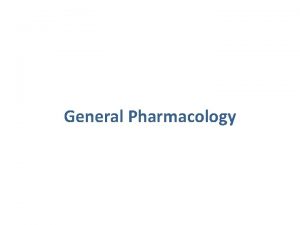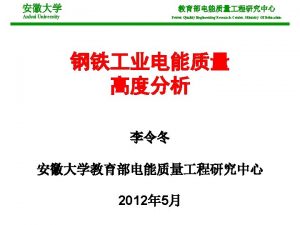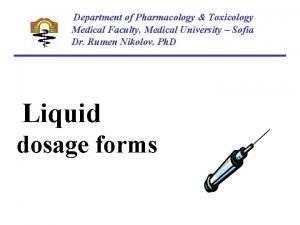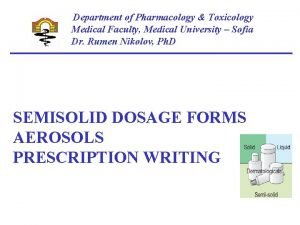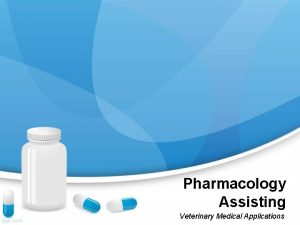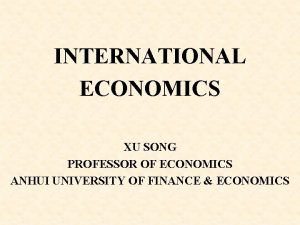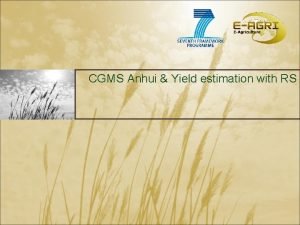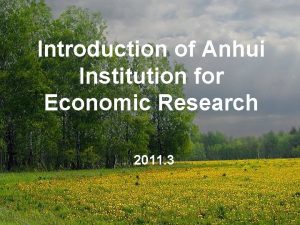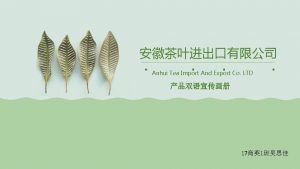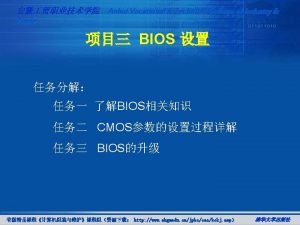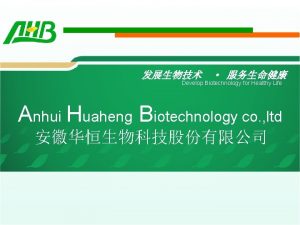Pharmacology Yang Dept of Pharmacology Anhui Medical University




























- Slides: 28

Pharmacology Yang Dept. of Pharmacology, Anhui Medical University Tel: 65161133, Email: yangyan@ahmu. edu. cn

• TEXTBOOK OF PHARMACOLOGY First edition. Original Editors:Bertram G. Katzung, et al. Chief Editor of Adaptation Edition :Zhou Honghao • TEXTBOOK OF PHARMACOLOGY Second edition. Original Editors:Bertram G. Katzung,Susan B. Masters,Anthony J. Trevor Chief Editor of Adaptation Edition :Zhou Honghao

Basic and Clinical Pharmacology 12/E


Chapter 1 Introduction of Pharmacology

Pharmacology # Pharmacology The science studying interaction between drugs and living organisms,used to prevent, diagnose, and treat disease. Chemicals administered to achieve a beneficial therapeutic effect on some process or for their toxic effects on regulatory processes in parasites infecting the patient.

Pharmacology # Medical pharmacology, defined as the science of substances used to prevent, diagnose, and treat disease. Toxicology is the branch of pharmacology that deals with the undesirable effects of chemicals on living systems, from individual cells to complex ecosystems.

Drug # A chemical substance which is utilized for the diagnosis, prevention and cure of an unwanted health condition (definition by FDA). By binding to regulatory molecules and activating or inhibiting normal body processes.

Categories of Drugs # 1. Replace physiological inadequacies, Insulin 2. Cure disease, Antibiotics 3. Treat symptoms, Antihypertensives 4. Prevent disease, Vaccine

Source of drugs Ancient l Natural products ─ ─ ─ Plants Animals Minerals Modern l Active principles of natural products l Artificial synthetics ─ ─ ─ Full synthetic Semi synthetic Biological engineering

From natural product to active principles Raw opium Opium tincture Poppy Relieve severe pain Morphine Codeine …

From natural product to active principles Foxglove Digoxin Deadly nightshade Atropine

Drug-body Interaction # • Pharmacology include: 1. Pharmacodynamics: actions of drugs on the body ("What the drug does to the body" ) 2. Pharmacokinetics: the fate of drugs in the body ("What the body does to the drug").

Drug-body Interaction Pharmacodynamics, PD Drug Action and Mechanism Absorption, Distribution, Metabolism, Excretion Pharmacokinetics, PK

What pharmacology is not … Pharmacy This is a separate profession responsible for the preparation and dispensation of medication. Pharmaceutical Science

Pharmacology is a crossroad to 药 理 学 Basic medicine Pharmacy 药理学 Develop new drugs Clinical medicine Medicine Pharmaceutical 中西医结合

History of medicines • Phase I: Superstition and Experience (Empiricism) — Alcohol--- pain, Willow-pelt---fever • Phase II: Using natural products to treat diseases – China: Sheng Nong’s Herbal Classic (神农本草经), described 365 TCM; Compendium of Materia Medica (本草纲目), described 1892 TCM – Greeks; e. g. Dioscorides: De materia medica (药物学), described 600 plants • Phase III: Scientific – Using pure drug compounds – Understanding physiopathology of diseases and pharmacology of drugs

Modern medicine relies heavily on drugs as the main tool of therapeutics. Otherapeutic procedures such as surgery, are also important, of course, but none is so widely applied as drugbased therapeutics

Drug Research and Development (R&D) • Preclinical Research: 1 Pharmaceutical studies 2 Pharmacological studies General pharmacology Pharmacodynamics Pharmacokinetics Toxicology

Drug Research and Development (R&D) • Clinical Research: 1 The Organizations for New Drug Food and Drug Administration (FDA) Sino(China) Food Drug Administration (SFDA CFDA) The Center for New Drug Evaluation. 2 Clinical Pharmacology: Phase Ⅰ, Ⅱ, Ⅲ and Ⅳ (Postmarketing Surveillance)

Drug Research and Development (R&D)

Drug Research and Development (R&D) Preclinical testing In vitro studies Animal testing Clinical trials Long-term toxicity studies Postmarketing surveillance (Phase 4) Phase 1 – normal volunteers: safety, pharmacokinetics Phase 2 – selected patients: therapeutic efficacy, dose range Phase 3 – large populations of selected patients: therapeutic efficacy, safety in double blind studies Average years: 1 -5 2 to 10 years 1 year

Process of Drug Development The Long Road to a New Medicine Application Marketing Phase Ⅲ clinical trial Phase I clinical trial Animal PK/PD/Tox Phase Ⅱ Clinical trial Dosage form Design synthesis Screen Candidate chemicals

High Risk Process 11 -15 Years, Much money ~100 design proposals Steps in Drug Approval Process Screen MMs chemicals • Isolation or development of new chemical • Animal studies • Human studies • New Drug Application Pre-clinical Clinical 1 – 2 product Pre-clinical 0 Idea Phase III 10 5 11 - 15 Years 15 Drug

What’s important for you… # 1. Drug action 2. Mechanism of action 3. Major adverse drug reaction 4. Clinically important pharmacokinetics 5. Clinical application

Outline of the course content Part I- Principles of Pharmacology: Pharmacokinetics; Pharmacodynamics Part II- Neuropharmacology: Efferent, central [or drugs that act on the central and autonomic nervous system]

Outline of the course content Part III – Drugs that act on cardiovascular system Part IV - Drugs that affect the viscera and endocrine system Part V – The chemo-therapeutic agents.

THANK YOU!
 Dept nmr spectroscopy
Dept nmr spectroscopy Department of agriculture consumer services
Department of agriculture consumer services Finance department organizational chart
Finance department organizational chart Worcester building department
Worcester building department Dept. name of organization
Dept. name of organization Mn dept of education
Mn dept of education Department of finance and administration
Department of finance and administration Dept. name of organization
Dept. name of organization Ohio dept of dd
Ohio dept of dd Dept. name of organization (of affiliation)
Dept. name of organization (of affiliation) Vaginal dept
Vaginal dept Gome dept
Gome dept Gome dept
Gome dept Nyttofunktion
Nyttofunktion Gome dept
Gome dept Hoe dept
Hoe dept Battalion chief interview questions
Battalion chief interview questions Oviposition
Oviposition Dept of education
Dept of education Florida dept of agriculture and consumer services
Florida dept of agriculture and consumer services Florida dept of agriculture and consumer services
Florida dept of agriculture and consumer services Dept a
Dept a Central islip fire dept
Central islip fire dept Rowan county dept of social services
Rowan county dept of social services Dept of education
Dept of education Bromocicloesano
Bromocicloesano Pt dept logistik
Pt dept logistik Nys department of homeland security
Nys department of homeland security La dept of revenue
La dept of revenue





























